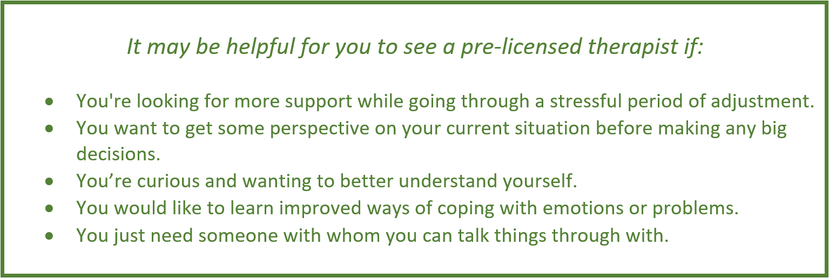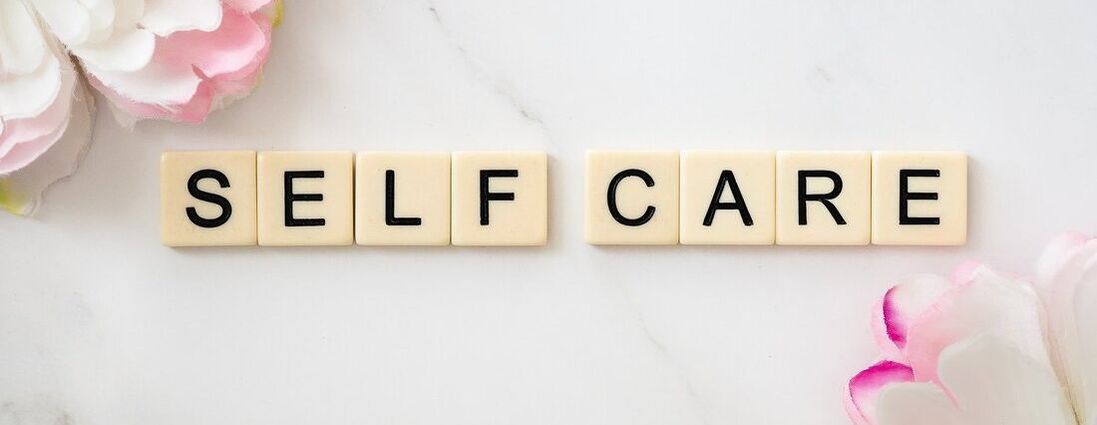|
Written by: Samara Perez, Prelicensed Therapist Survivors are strong individuals who have overcome some difficulty or traumatic experience. Surviving a sexual assault is a traumatic experience as it violates the body and mind. Boundaries have been crossed and it feels like all control over the situation has been lost. This is when the mind decides to go into fight, flight, or freeze mode. Your mind does this to protect you from the mental and physical pains of being violated and to help you survive the experience. While this process can be a protective factor in the moment, sometimes these mechanisms can be detrimental if they persist for too long. When this happens, it can be considered a trauma response.
Trauma responses are often described as feeling sad a lot of the time and mentally replaying the experience over and over again. There are unfortunately more symptoms that people don’t know exist. These include dissociation, having trouble sleeping, developing illnesses and autoimmune diseases, having gastrointestinal issues, self-destructive behaviors, becoming more of a people-pleaser and more. After a traumatic experience like sexual assault, our minds are heightened to recognize danger in every corner. Sometimes our minds work too well and categorize something as dangerous when it isn’t. With psychoeducation, we can understand more about why our minds and bodies behave like this and we can learn how to grow from our experiences. Schedule an appointment to learn how to better understand and care for your body’s responses, cope with future uncomfortable situations, and heal what was once broken.
0 Comments
Written by: Kaycee Beglau, PsyD Psychotherapy can be a wonderful way to better understand yourself and improve your life. Psychotherapy can help you process past traumas, get through difficult emotions, and learn new coping skills. It can also be a helpful part of recovery from substance abuse, help you improve your relationships with others, or even to be a better parent to your children. But not everyone can afford to see a licensed therapist. If you're looking for some guidance without breaking the bank, pre-licensed therapists are one option to consider. What's a pre-licensed therapist? A pre-licensed therapist is someone who has graduated from a master's degree program but has not yet passed the licensing exam or accumulated enough post-graduate supervised hours to meet the licensure requirements. While every state has different requirements for licensure, in the state of Pennsylvania, master’s level therapists are required to earn 3,000 hours of supervised clinical experience over a minimum of 2 years. During these 2 years, they are required to spend at least 2 hours each week in supervision with an experienced, licensed clinician who is there to guide them and help them continue developing and applying their skills. Pre-licensed therapists will have gained some experience in their graduate training program, through their practicums and internships. They have most of the skills and knowledge of a licensed therapist, but simply haven’t “been around the block” as much as licensed professional. While there are pros and cons to this, they are still highly knowledgeable and committed to helping clients heal and grow into their best selves! Why see a pre-licensed therapist? There are many reasons why you may want to see a pre-licensed therapist. Some of the most common include:
Are there downsides to seeing a pre-licensed therapist? There are a few downsides to seeing a pre-licensed therapist. First, as noted above, they may not be able to provide the same level of care as someone who is licensed. This is because their training and experience are limited. Even though they have gone through the necessary education to earn their master's degree in counseling and have an understanding of the field (and probably even more than some fully licensed clinicians), not having that extra qualification could mean that they don't have access to certain treatments or techniques that may be helpful for you. Additionally, if your health insurance doesn't cover out-of-network mental health care costs—or if it only covers therapy delivered by licensed professionals—you may not be able to submit claims for out-of-network reimbursement. Conclusion As you can see, there are many benefits to seeing a pre-licensed therapist. They’re more affordable and their training is similar to that of licensed therapists. Although they may not have all the skills of a licensed therapist yet, they’ll still be able to help you work through your problems with a supportive environment that can give you valuable insight into how therapy works in general. So, if you’re looking for someone who offers reasonable rates on therapy sessions or just want someone with less experience but still has an understanding of what it means to be in therapy then pre-licensed therapists are definitely worth considering!
At Turning Leaf Therapy, we take our training program very seriously, and hand select the most qualified applicants from a very large pool. We invest heavily in their training and supervision to ensure you get the best care possible! Written by: Kaycee Beglau, PsyD If you read the previous blog post, you will already know that tantrums are most often communication of an unmet need that arises in response to a child’s nervous system being activated and going into fight-or-flight. Once you understand this, you will also understand that the child does not need to be punished in order for the tantrum to end (and that actually this can cause them to shut down when they really need your support). But you may be wondering what to do instead. I am going to break this approach down into 3 basic steps, as a place to start for anyone who is trying to understand how to “break the cycle” and parent differently in a more considerate and respectful way.
1. Stay Calm If this is the only thing you can accomplish, then this is a lot! Staying calm is most often the hardest and most important part of the process. Any activation in your nervous system will feed into the activation in your child’s body and nervous system. It's like pouring fuel on the fire. So, do whatever it is that you need to do to keep yourself calm, to refrain from raising your voice, or even making passive-aggressive or shaming comments or non-verbal sounds or facial expressions (we all know the eye roll or the loud sigh, don’t we?). 2. Wait Get down on their level in a non-threatening way. Sit on the floor with your legs crossed and your arms in an open, non-threatening position. You can offer validation of their emotions, not of their behavior. For example, stating something like, “I can see you’re feeling really angry. It's not ok to throw your blocks, but I get that you're upset and that’s ok.” If validation seems to increase their emotional reactivity, just be silent but present. You can model for them how to take some deep breaths by doing this yourself if you feel like you must “do something.” But really, the child just needs to know you are there with them, they are safe in your presence, and you are there waiting to reconnect with them once they are ready. 3. Offer Co-Regulation Offer to give a hug. If they reject the hug, say “that’s ok, I am here when you are ready.” Give the child some space by remaining present and quiet, and then you can say “are you ready for a hug, now? Let me know when you would like a hug.” Don’t force the hug, but continue to let them know you are here to help them and that you aren’t mad at them and they aren’t in trouble. Often the child just needs a moment to feel their feelings and then they will eventually gladly accept the hug. Hugs are often a magical way to calm the body and reconnect. If your child doesn’t want a hug, you can try offering another calming activity that you know they will find helpful. For example, saying “do you want to blow the angries out with me?” and demonstrating taking some deep breaths and blowing the air out through your mouth or blowing actual bubbles with them. Maybe they want to color really hard with a crayon of their choice or squeeze a teddy bear really hard. This part takes some trial and error, but finding strategies to help the child release the emotional energy that they are feeling in their body, along with you as their safe and secure base, can help them re-regulate the intensity of the emotions that they are experiencing. Once the child is in a more regulated state, you can then talk to them about what happened that got them so upset in the first place. Maybe you want to explain a boundary to them or teach them that certain behaviors are not acceptable, such as throwing items or hitting their sibling. Whatever it is that you want to teach them, the time to do it is after they are fully regulated and feel reconnected to you. Then, they can actually listen, process, and integrate the lesson you want to teach them. Of course, in real life, these three simple steps are often much more difficult to implement than what a blog might imply. It takes time to try things out, to find what works for your specific child, and to also understand that the effectiveness of solutions like this build gradually over time (meaning, this is not meant to be a quick-fix solution). But, with practice over time, your child will be building new neural pathways through the co-regulation process with you, so that as they get older, they will eventually be able to self-regulate and feel confident and connected with you as their parent. If you are struggling with knowing how to respond to your child in a responsive, assertive, but connected way, it can be really helpful to work with a child and family therapist that can demonstrate, model, and coach you through this process. If you are looking for such support, we have a highly skilled therapist who specializes in helping parents do just this! Check her out or contact us to schedule an appointment with Ali Thieman, LCSW to get started. Written by: Kaycee Beglau, PsyD How many of us were raised with authoritarian parents? You know, the ones that tend to view anything their child does that is undesirable as a “behavioral problem” or something that should be “punished” or “disciplined” out of them? Because, if you don’t give “consequences,” then you’re a bad parent and your child is going to grow up to be a terrible person, right?
If you were raised with parents that sound something like this, you may be inclined to view your child’s tantrums or emotional meltdowns as a behavioral problem, or something that you need to discipline or punish out of your child. This mindset leads most parents to feel incredibly frustrated or even shameful because it must mean you are a bad parent and failing them in some profound way. In response to these feelings, parents find themselves trying a variety of solutions to manage their child’s behavior, all the way from giving time-outs (aka, forced isolation) to instill a variety of ineffective “consequences” (aka, taking things away) or making threats, yelling, etc. Sometimes these strategies may even seem to “with you, as their parent?work,” meaning, they decrease or stop the undesirable behavior. However, just because it looks like it “works,” we need to ask ourselves what is actually going on inside the child that you cannot see and that is being shut down with these kinds of responses. What is it costing in terms of both the child’s development and in terms of their relationship with you, as their parent? The truth is – and this may be shocking for anyone who grew up with discipline and behavior-focused parents – is that tantrums are literally a stress response in your child’s nervous system. Whatever the original trigger is – this has set off a stress response (aka, the fight-or-flight response) in their nervous system. Their little bodies are totally overwhelmed and they feel completely out of control when this is happening and they are unable to calm down or even process what you are saying in the heat of the moment. What does this mean? It means that they need help from you in order to calm down first before anything else can happen. This means that when they are having a meltdown, and someone is yelling at them or making threats to take something away if they don’t stop – they literally cannot “hear” this or process it and then simply choose to do something different in that moment, no matter how much they might want to. Being placed in a time-out means they are forced to be alone to calm themselves down when in reality, little children do not yet have this ability (developmentally speaking). They require co-regulation, or help from a safe, secure “other,” in order to calm their bodies and to be able to hear and think and process again. While it doesn’t make sense to adults that, for example, being told “no, you can’t have a cookie before dinner” would trigger a stress response such as the fight-or-flight response, little ones do not have the capacity to self-regulate the sometimes very intense feelings of anger, rage, disappointment, sadness, etc., that can come after a limit or boundary is set. It is the overwhelming intensity of the raw emotions that little ones feel, coupled with their underdeveloped ability to regulate feelings, communicate effectively, express themselves, problem-solve, delay gratification, tolerate frustration, etc., that leads to the activation of their nervous system and the fight-or-flight response. This activation of the nervous system is then expressed through the “tantrum” or meltdown, which is what is being witnessed and interpreted as a “bad behavior” by the adult. Once this response is activated, the best thing that you can do is understand what is actually happening inside your child, to understand they are not “acting badly” or even trying to “manipulate” you. And with your understanding, empathy and compassion will naturally flow and space can open up for you to find a new, more connected way of being with and responding to your child when they actually need you the most. It’s all about helping your child find ways of calming their body and teaching them over time how to regulate their nervous system when it gets activated like this. A big part of parenting can feel like having to “unlearn” the ways we were taught or had modeled for us. And it may feel like you have no idea what to do instead. And it can feel scary to try on new perspectives and new ways of being with your child and responding to different behaviors or big emotions that emerge. It can also feel overwhelmingly confusing. If you are trying to break the cycle in your parenting, check out the next blog in this series, How To Calmly Help A Child In An Emotional Meltdown. It can also help to have a lot of support. A really good child and family therapist can help you learn how to better attune to your child, understand their behavior as a communication of unmet needs (and not necessarily a disciplinary problem or a reflection of your bad parenting), and learn new and better ways of teaching, guiding, and parenting your child in ways that will build up your child and strengthen your bond with them. If you are looking for such support, we have a highly skilled therapist who specializes in helping parents do just this! Check her out or contact us to schedule an appointment with Ali Thieman, LCSW to get started. Written by: John Kreitzberg, MA Past traumatic experiences can have profound and long-lasting impacts on the lives of survivors. After experiencing trauma, people often feel extremely alone and unable to find others who not only relate to their experience but who also understand all the different ways those traumas continue to impact them today. Group therapy is often used with survivors of trauma to combat feelings of isolation by providing a safe and supportive environment with other survivors. Some trauma group therapies dig deep into members’ trauma histories to process and restructure the memory of traumatic experiences. In this post, however, we will look at a different form of group trauma therapy: present-focused therapy.
It may seem counterintuitive to have a trauma group in which members don’t discuss their trauma stories, but that’s exactly what present-focused group trauma therapy does. By focusing on the current day-to-day impacts of trauma that survivors experience, this type of group helps members find ways to move from the past to the present, discover ways to cope with trauma reactions, and explore new ways of relating to themselves and those around them — all within a safe and collaborative group setting. While every survivor’s experience is different, there are a number of common ways that trauma may impact someone’s daily life. When we think of trauma responses, we might immediately think about some of the “classic” symptoms such as being easily startled or experiencing intrusive memories of the trauma. While these are both very real responses to trauma, survivors also often experience profound changes to how they think about themselves, relate to others, and understand the world around them. Some common issues that survivors experience include:
One of the most powerful aspects of group therapy is that the group becomes a microcosm of the group member’s world, and the issues members face in the world start to play out within the group itself. Staying in the here-and-now, present-focused group trauma therapy provides members a safe place to examine these issues, receive feedback and problem-solving strategies from other members, and explore new and healthy ways of relating to each other. Ultimately, members of a present-focused trauma group can expect:
At Turning Leaf Therapy, we have taken the need for safety precautions very seriously and rapidly moved to implement our approach to therapy online. At this point, our current clients have already had a chance to settle-in to this new way of meeting with their therapist. We also recognize if you are a new or returning client, you may have some questions or concerns about how this process works or if it's worth it.
How does online therapy work? We are currently using a secure, HIPAA compliant, online platform called Doxy.me to conduct our online therapy sessions. It is very user-friendly and allows you to connect with your therapist during your session time from any device that is connected to the internet, including your laptop or phone. You do not need to download an App or create an account to log in. You will simply receive a link from your new therapist and can click on it to join them in the “virtual waiting room.” How do I get started with a new therapist? To get started with a new therapist, please contact our intake coordinator, Michelle Matthews, to find out which therapists currently have availability, to discuss therapy and scheduling options, and to see who may be the best fit for you. Michelle will take down some of your information, including your insurance information if you are wanting to use that to cover the costs of services. They will verify your insurance information and schedule an initial appointment for you with one of our available therapists. You will then be provided with a personal room link via email that you can continue to use to connect with your therapist for each appointment thereafter. Will my sessions still be confidential and secure? Yes! We take our job of maintaining your privacy very seriously as well. The platform we use, Doxy.me, meets HIPAA, PIPEDA, and ADPR data privacy requirements and none of your sessions are recorded or information is stored. What do I need in order to use Doxy.me? As previously stated, you do not need to download or sign up for an account to use Doxy.me. All you need is a device with a screen and audio abilities that is connected to the internet. It is strongly advised that you use a private, secure internet connection and refrain from using public Wi-Fi. *To ensure the best possible audio experience, it is highly recommended you use earphones to decrease echo and other background noises. What is the cost and will insurance cover these sessions? The fee for online therapy is the same fee as in-person therapy. If you have concerns about your ability to pay for your sessions, please discuss this further with your therapist. Many insurance companies have removed restrictions to telehealth and are agreeing to cover the costs of online therapy, at least during the time of the Coronavirus-related state of emergency. Some companies have also chosen to waive copays and deductibles during this time. However, this is a rapidly changing time, where information is in a constant state of flux. We believe most people that would be covered for in-person sessions will be covered, but we are encouraging our clients to stay in contact with their individual insurance carriers to stay up to date with current requirements. Guest Blogger: Anne Miller-Uueda, LCSW Working From Home and Parenting Self-Care if You Are Working from Home Designate a workspace. Explore designating a separate space in your home that is only for work. If you are in a small space and cannot do this, another option is creating some visual changes when you are “at work” versus “at home” to remind yourself that work has ended. Hold boundaries. For most people, now is not the time to loosen up on your work-life boundaries. If you didn’t check your email during weekends or after 5:00 before, try not to now. If you are already in the habit of working 24/7, maybe ask yourself if that is working for you in the current situation and explore what boundaries you need right now. Take breaks. If you can, make sure you are still taking your lunch break or start taking a lunch break. Even if you can only get away for 5 minutes, take some time away from your computer and give your mind a chance to reset while you refuel your body. Self-Care If You Are Also Parenting Practice self-compassion. I know I already mentioned self-compassion, but I want to mention it again. Maybe your kids are getting more screen time right now than is the norm, maybe they aren’t learning as much as they did in school, maybe there are other things that are slipping for which you are beating yourself up. You are doing the best that you can in a very hard situation. Acknowledge yourself for that! And when you can’t be kind to yourself, reach out to another empathetic parent who can help you be kind to you. Practice mindfulness. I know this is another repeat. Remember that mindfulness is being present in the moment. When you can, try to be present with your kids, whatever it is you are doing in that moment. This type of mindfulness can open up mundane interactions to be more intentional and meaningful. Take breaks. If you are able, try to take a break and have some alone time. This might mean you have to recruit your partner and trade times alone, or it may just have to be the time you have after your kids are in bed. You deserve some time just for you. Mindfulness and Self-Compassion Resources:
Reliable sources of information regarding COVID-19:
Parenting: New York Times’ Parenting During COVID-19 Collection: https://www.nytimes.com/spotlight/parenting-kids-coronavirus Guest Blogger: Anne Miller-Uueda, LCSW Taking care of Emotional and Spiritual Needs Emotional Self-Care Do something you like. A lot of activities are restricted right now, but not all. Maybe re-read your favorite book, have a dance party in your kitchen to your favorite song, do a puzzle, knit, take a bath, listen to music, sit on your front steps and listen to the birds, write, create art, cook, bake, play with your pet or child, color, read poetry… Laugh! If you can, find something that always makes you laugh. It could be clips of your favorite late-night host or comedian on YouTube, your favorite Shakespeare comedy, your favorite video of your two-year-old imitating your partner, a comedy podcast – anything! Practice self-compassion. Try to talk to yourself as kindly as you would talk to a friend. We can often be much harder on ourselves than others. Spiritual Self-Care Practice mindfulness. Mindfulness is simply being in the moment. This is much easier said than done, and it is often so worth the practice it takes. Focusing on your breath or engaging with your senses are a couple ways to do this. There are many other ways to practice mindfulness and many mindfulness resources are making some of their content free right now (see the resources at the bottom of this blog for a few suggestions). Get outside and notice nature. There are many places that you can be outside and stay 6 feet from others. If you are having difficulty accessing outdoor spaces, you can sit on your front steps or even be by an open window for 15 minutes a day. Access your spirituality. This can look different for everyone but try to be in touch with your higher power or access your version of spirituality. You know your belief system best, so you know how to best do this. Mindfulness and Self-Compassion Resources:
Reliable sources of information regarding COVID-19:
Parenting: New York Times’ Parenting During COVID-19 Collection: https://www.nytimes.com/spotlight/parenting-kids-coronavirus Guest Blogger: Anne Miller-Uueda, LCSW Basic self-care essentials As public health officials and healthcare providers around the country and the world try to slow the spread of COVID-19, most Philadelphians, indeed most Americans, have been told to stay at home. While this is so important for public health, it can be hard on an individual’s mental health. For those who have pre-existing anxiety or depression, or a history of trauma, staying at home and interacting with the realities of this crisis can exacerbate symptoms. Self-care, while not a cure-all, can certainly decrease vulnerability to increased anxiety, depression, and trauma symptoms, as well as help us manage some of the intense emotions that are coming up for so many people right now. Self-care during this time may look different than it used to. Prior to this crisis, many people would go to the gym, socialize with friends, participate in recreational sports, sing in community choirs, and other out-of-the-home activities. While we are being asked to engage in social distancing, these things may not be possible. That does not mean self-care is not possible. The rest of this blog will provide some ideas about ways to engage in self-care right now. However, remember, self-care is a personal thing and it is important to experiment to find out what works for you. Physical Self-Care Move. As much as you are able, be intentional about moving every day. This could be going for a walk or run outside (while trying your best to stay 6 feet from other walkers and runners of course!), doing an exercise video, engaging in some self-guided yoga or stretching, walking up and down your stairs, chasing your kids around the living room – anything that gets your body moving within your ability. Eat healthy. Try to pay attention to what you are putting into your body. Boredom can be a trigger for many people to eat, drink alcohol, or use other substances. Experiment with noticing if you are eating or drinking in ways that are different. Try to keep healthy food in your home so that when you are hungry you have a healthy option available. Sleep. If you can, try to keep a regular sleep schedule (I recognize this is difficult for folks doing shift work). Even though many people’s schedules have gone out the window being at home, as much as you can try to stick to a regular bedtime and wake up time. We sleep best when our body knows what time we are going to bed and waking up each day. In addition to keeping a regular schedule, sleep is improved by:
Psychological Self-Care Limit news and social media. It is imperative to know what is going on right now and the current recommendations. At the same time, it is generally not helpful for people to spend several hours a day reading the news. Try to pick one or two places you will get your updates. There has also been a lot of misinformation being circulated on social media, so check your sources. Pay attention to your thoughts and feelings. When you are able, check in with yourself – notice what you are thinking and what you are feeling. Try naming your feelings. If you are having thoughts that are leading to anxiety or depressed feelings, ask yourself:
Practice gratitude. Explore noticing that for which you feel grateful every day. You might even consider starting a gratitude journal – just write down three things a day for which you are grateful. Personal Self-Care Shower and get dressed every day. It can really help your mood to get out of your pajamas, even if you are not putting on normal work clothes, or at least not normal work pants. Stay connected. Friendships and connection enhance well-being. Socializing during this time is difficult. As you are able, try to keep your connections and friendships alive, even while you cannot be face-to-face. Call, video chat, write letters, play virtual boardgames, listen to the same radio station and dance to the same songs, text, send smoke signals (ok – maybe not the last one, but try to keep in touch). Engage in meaningful activity every day. Many people have a lot of extra time on their hands right now (many other people have a lot less extra time on their hands). If you do have a lot of extra time, it can be easy to sink into a bog of mindlessly watching Netflix. Experiment with being intentional about doing something meaningful every day. For some people this could be their work or the parenting they are already doing. For others this could be learning something new, creating art, writing, dropping off groceries for an elderly neighbor, or volunteering to help keep non-profits running through the city of Philadelphia (https://www.phila.gov/2020-03-19-philadelphias-response-to-covid-19-how-you-can-help/ ). Mindfulness and Self-Compassion Resources:
Reliable sources of information regarding COVID-19:
Parenting: New York Times’ Parenting During COVID-19 Collection: https://www.nytimes.com/spotlight/parenting-kids-coronavirus Written by: Kaycee Beglau, PsyD As the coronavirus continues to spread across the United States and the world, many of us are left looking towards the internet for creative ways to meet some of our physical, emotional, and social needs. With the growing government restrictions and orders for social distancing, sheltering in place, and the closing of all non-life sustaining businesses, the opportunity to begin in-person therapy is likely to be extremely limited. This is, of course, occurring during a time when many of us are experiencing unprecedentedly high levels of fear, panic, anxiety and worry, isolation, loneliness, sadness, grief and loss, among other overwhelming and complicated emotional reactions. Under more typical circumstances, I imagine many folks would be quickly trying to find a new therapist to help them process and cope during these overwhelming times. As it currently stands, if someone wants to begin therapy, they are left with understandable questions or concerns about what it would mean to meet a new therapist for the first time online and to begin working with them in this manner without ever having met them in person, or wondering if this is even a realistic possibility at all. Let me start by saying that, yes, it is possible to begin a new therapy remotely or online. Although online therapy (also referred to as telehealth, telemedicine, virtual therapy, distance therapy, telepsychology, web therapy) has been around for many years, it has recently been growing in popularity among some office-based therapists, and also because of the development of several text-based or app-based companies offering only distance therapy options. Even so, I believe most people (both therapists and clients alike) would agree there are potential downsides and costs to receiving therapy in this format, with something being “lost” without the ability to be physically in the same room with one another in a fully embodied way. While downsides to online therapy will not diminish during the coronavirus crisis, the potential benefits of starting to work with a therapist remotely, will likely outweigh the costs, particularly if you can begin working with a local therapist who can eventually transition into in-person therapy once it is deemed safe for everyone to do so. Some of these potential benefits may seem rather obvious, such as having increased contact with another human being, being able to receive support, and learning new ways of coping with overwhelming feelings. However, there are many other potential benefits, that may include:
If you are emotionally struggling or suffering, or could even just use some more support, please do not hesitate to contact local therapists and inquire about their current procedures for beginning therapy remotely. It may be helpful to write down a list of questions or concerns ahead of time, so that you get a chance to discuss these prior to your first session. I know this may seem like a lot of work during an already overwhelming time, but many therapists have already made this transition successfully and are eager to help provide support during this time when it is needed the most. Mindfulness and Self-Compassion Resources:
Reliable sources of information regarding COVID-19:
Parenting: New York Times’ Parenting During COVID-19 Collection: https://www.nytimes.com/spotlight/parenting-kids-coronavirus |
|
We are a full-service private practice offering a variety of therapeutic services conveniently located in Old City, Philadelphia.
|
Important Links
Blog
|
GET IN TOUCH |
Copyright © 2018 Turning Leaf Therapy LLC All Rights Reserved.














